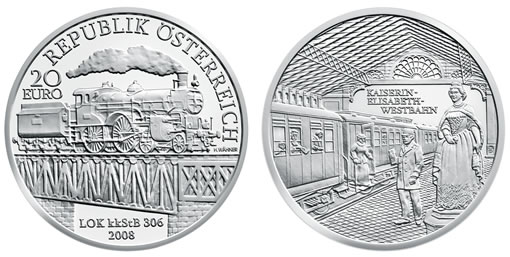The Austrian Mint has issued the fourth 20 Euro silver commemorative coin within the "Austrian Railways" six silver coin series. The coin is dedicated to the "Empress Elisabeth West Railway" from Vienna to Salzburg, which was constructed between 1856 and 1860. It features locomotive "kkStB 306" steaming across an iron railway bridge and a superbly crafted scene depicting the platform hall of the West Railway Station in Vienna.

In the Austrian Empire the railway lines north to the coalfields and factories of Bohemia or south to the harbour of Trieste and the Adriatic shipping lanes were by far the most important. A railway line from Vienna westwards parallel to the Danube River was of less consequence. However, the Kingdom of Bavaria was very anxious to see such a line between Salzburg and Vienna, which would enable trains from Munich to travel eastwards through Hungary and down to Constantinople. Plans by the government to build such a line were subsequently abandoned in 1856 to a private consortium, the Empress Elisabeth Railway Company.
Construction began in 1856 and by late 1858 the line had reached the city of Linz. In the next two years the line was extended to Salzburg, the first train from Vienna arriving on 26th May, 1860. The official opening was not until 12th August. On that day the Emperor Franz Joseph coming from Vienna and King Maximilian II of Bavaria coming from Munich arrived in the Salzburg Railway Station at precisely the same time. The official opening was followed by celebrations first in Munich and then in Vienna. The new line would also be used by Franz Joseph to travel to his beloved Bad Ischl in Summer, and by the Empress Elisabeth herself to travel home to see her family in Bavaria.
The locomotive 306 which appears on the obverse of the new coin, was designed and built in 1908 by the chief engineer Karl Gölsdorf. Unfortunately, it proved insufficiently strong to move the new heavy express trains and consequently only three engines of this model were constructed. The locomotive 306 was then employed in pulling the imperial court trains which Emperor Franz Joseph and members of the imperial family used on their frequent journeys throughout the Empire. Each line placed such a special train at the disposal of the imperial family, although the journeys themselves were billed to the court.
In 1881 the Empress Elisabeth West Railway, which had been struggling with financial problems, fell victim to the government’s plans to bring all the railways under the control of the Imperial State Railways. The entire network of lines and the running of all trains were incorporated into the state system. In 1884 the Empress Elisabeth West Railway was officially nationalised. After the First World War with the dismemberment of the Habsburg Empire, the North and South Railways declined in significance. The West Railway became (and remains) the most important line in the Republic of Austria.
The new silver 20-Euro coin shows the locomotive 306 steaming across an iron railway bridge. The reverse side depicts the platform hall of the West Railway Station in Vienna. A train has just arrived and the passengers begin to disembark. A railway official stands with a timetable in hand to assist passengers with inquiries. To the right is the statue of the Empress Elisabeth, who gave her name to the line. This figure was in the entrance to the old station, and although damaged in the Second World War, it stood until recently in the entrance hall of the new West Station.
The new coin is struck in 900 fine silver in proof quality only and to a maximum mintage of 50,000 pieces. Each coin is issued in an attractive box with a numbered certificate of authenticity. A prestigious collection case for the entire series can be purchased separately.
The new "Empress Elisabeth West Railway" coin has already been received with enthusiasm by coin collectors and railway fans the world over.
# # #
Coin specifications for 20 euro, "Empress Elisabeth West Railway"
| Alloy: | Silver, Ag 900 |
| Finish: | Proof |
| Edge: | Grained |
| Diameter: | 34 mm |
| Total Weight: | 20 g |
| Fine Weight: | 18 g |
| Mintage: | 50,000 |
| Date of Issue: | 10 September 2008 |
| Face Value: | 20 euro |
| Designer: | Helmut Andexlinger and Thomas Pesendorfer |
The coin may be ordered through the Austrian Mint website.
About the Austrian Mint
The Austrian Mint is situated in the heart of Vienna and is the official minting authority for Austria with a 800 year history.
The Mint is the source for all Austrian Euro and Cent coins, whether they are intended for shopping, as an investment or for collection. Before the Euro, the Schilling and Groschen coins were minted, and before that – during the monarchy – Crowns, Guilders and Ducats were struck by the Austrian Mint.
The company is located close to the centre at the Vienna Stadtpark in a Biedermeier building erected under Emperor Ferdinand I. from 1835 to 1837. Today it accommodates one of the most modern mints in the world.





